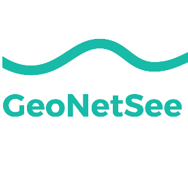Projects
GeoNetSee An AI/IoT –based system of GEOsensor NETworks for real-time monitoring of unStablE tErrain and artificial structures
GeoNetSee will create a solution for monitoring unstable terrain and artificial structures, which will include a geosensor network and a platform for collecting, processing, and visualizing collected data in real-time. The GeoNetSee system will be tested in both laboratory and operational environments (3 countries as pilot sites and 6 as testing sites).The solution will include the installation of permanent CORS stations in Serbia, Montenegro, and Bosnia & Herzegovina, that would join the European Plate Observing System (EPOS) which also includes the EUREF Permanent global positioning satellite systems (GNSS) Network (EPN).

GeoSES - Extension of the operational "Space Emergency System" towards monitoring of dangerous natural and man-made geo-processes in the HU-SK-RO-UA cross-border region
The project fits to TO8 Common challenges in the field of safety and security Priority 1. The overall objective of the project is geomonitoring of natural and man-made processes in the cross-border territory with the aim of preventing of emergency situations. The project will integrate advanced techniques in new, coordinated and innovative ways in order to improve our understanding of land deformation (landslides) on Tyzsa River and its effect on the environment. The main task of the Self-government of Szabolcs-Szatmár-Bereg county is the elaboration of climate strategy of the target cross-border area (Carpathian Region). More details......

INTRO - INtegrity of TROposphere models
The project funded by the European Space Agency aimed at the estimation of the maximum residual error of the tropospheric delays for the estimation of system integrity for safety-of-life positioning applications.More details......

Ulyxes project
The Ulyxes project is an open source project of our department started in 2008. The aim of the project to drive robotic total stations and other location-aware sensors, to collect observations and to publish them on the Internet. Our students are also involved in the project. More details......
Assessment techniques of tropospheric effects for local augmentation systems (TROPSY)
In the frame of TROPSY project a new tropospheric signal delay model will be obtained using the recent meteorological data. The derived model will be tested under different weather conditions, user positions (including locations with height more than 2 km above mean sea level) and on low satellite elevation angles (starting with 2 degrees). Our aim is to provide a more sophisticated model for aviation applications, such as precision landing. More details...


